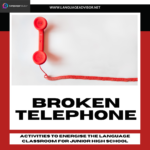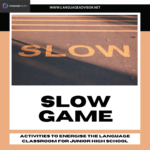WHAT DID YOU HEAR? Games and Activities to Energise the Language Classroom for Junior High School
WHAT DID YOU HEAR?

Energising Language Classroom Activities for Junior High School: A Teacher’s Guide
Junior high school students often find language classes challenging, but as a language teacher, you have the power to transform these challenges into engaging learning experiences. Classroom activities are the key to achieving this transformation. These activities not only make learning enjoyable but also foster a deeper understanding of the language, leading to improved fluency and proficiency. In this blog post, we will explore a diverse range of innovative and interactive language classroom activities designed specifically for junior high school students. Whether you’re looking to enhance vocabulary retention, boost conversational skills, or make grammar lessons more enjoyable, this guide will provide you with a rich array of strategies to create a dynamic and effective learning environment for your students. Let’s embark on this journey to energize your language classroom and inspire your students to become passionate language learners.





WHAT DID YOU HEAR?
Target Group: All grades
Difficulty Level: Fundamentals
Activity Objective: To strengthen and apply listening comprehension skills
WHAT DID YOU HEAR? – Procedure
- Main Objective: The primary goal of this English teacher’s self-introduction presentation is to actively engage students and enhance their listening comprehension skills.
- Components: The lesson plan includes both audio and visual components. The teacher’s presentation serves as the audio element, while the visual component comprises the PowerPoint slides and images displayed during the presentation.
- Active Student Engagement: To ensure active student engagement, the teacher should ask students questions during the presentation. These questions can be simple, such as “What is this?” or “Do you have any pets?” Students may respond in English or Japanese, and any form of participation is valuable. If students answer in Japanese, the teacher can seek the English equivalent, even if it seems obvious from the displayed images. The aim is to eliminate any potential miscommunication. Additionally, it’s essential to reinforce new words by writing them on the board.
- Quiz Time: A handout should be distributed to students before the presentation, allowing them to take notes on what they hear. While this might seem counterintuitive, it can boost students’ confidence when it’s time to participate in class. The teacher will ask students questions about what they’ve learned during the presentation. This segment of the lesson is both enjoyable and serves as an effective listening comprehension and speaking practice exercise. When responding to correct answers, the teacher should follow up with complete sentences, such as, “Yes, I have two brothers.”
Materials and Preparation
Prepare images that represent your home country, images of yourself, family, pets and home. Make a simple question sheet with two options and then ask your question out loud. Create a very simple handout with six boxes and each box had two options, such as, 25 years or 21 years old and 1 pet or 2 pets. You should also prepare bonus questions as you may find yourself with extra time left.
Suggestions and Advice
Just as each person has their own individual personality, each class has its own personality. You may get a class where no one will raise their hand and you may get a class where students may raise their hands or shout out the answers. My advice for a class that is hesitate to participate it to do a
class poll— for example ask students to raise their hand if they think choice A is right or choice B.
For livelier classes make sure to keep up the classroom energy by rewarding students who participate. In my case, I would give a high five or fist bump to any student that participated and then have the class give that student a round of applause; it helped keep students engaged and willing to participate. Also, when asking the questions start by saying question one and as I proceeded along I would count off and have the students say the next number. Another fun piece of advice would be to have students stretch before you ask them questions, and build up the energy by doing a drum roll and ask them if they are ready. You are introducing yourself to students, but you also want to take the opportunity to have students be active listeners. Lastly, remember to speak slowly, your students might not be accustomed to a native speaker`s speaking rhythm.





Energising Language Classroom Activities for Junior High School
In the world of language teaching, fostering a love for learning and effective communication is our ultimate goal. By implementing these engaging classroom activities for junior high school students, you are not only enhancing their language skills but also creating an environment where curiosity, creativity, and enthusiasm thrive. As we wrap up our exploration of these energizing language activities, remember that your role as a teacher is invaluable, and your dedication to making language learning exciting and impactful is what sets the stage for your students’ future success.
So, continue to innovate, adapt, and personalize these activities to suit the unique needs and interests of your students. Watch as their confidence soars, their vocabulary expands, and their ability to communicate fluently grows. With your guidance and these engaging activities in your teaching toolbox, you are well on your way to inspiring a new generation of confident and capable language learners. The journey to language proficiency may be challenging, but with your passion and these activities, it is always an exciting one.
Happy teaching!





Also check out these articles on teaching, teaching methods and teaching tools
















